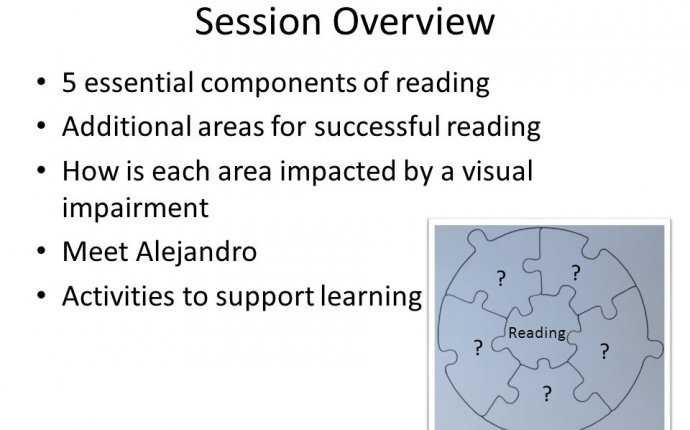
Teaching strategies for visual impairment
There is a range of inclusive teaching strategies that can assist all students to learn but there are some specific strategies that are useful in teaching a group which includes students with visual impairments.
In considering alternative forms of assessment, equal opportunity, not a guaranteed outcome, is the objective. You are not expected to lower standards to accommodate students with a disability, but rather are required to give them a reasonable opportunity to demonstrate what they have learned.
First Day
- Invite students to self-identify on the first day of class by making a public statement such as: "Please contact me to discuss disability accommodations."
- Have copies of the syllabus and reading assignments ready no less than six weeks prior to the beginning of classes so documents are available for timely transcription into alternative formats.
Lectures and Other Teaching Sessions
- Keep instructions brief and uncomplicated as much as possible. When repeating instructions, repeat exactly without paraphrasing.
- Clearly define course requirements, the dates of exams, and when assignments are due. Provide advance notice of any changes.
- Present lecture information in a visual format (e.g., chalkboard, overheads, PowerPoint slides, handouts, etc.).
- Use more than one way to demonstrate or explain information.
- When teaching, state objectives, review previous lessons and summarize periodically.
- Provide vision-impaired students with materials in alternative formats at the same time the materials are given to the rest of the class. The student must specify the preferred format, such as enlarged font.
- Make instructional on-line course materials available in text form. For that material which is graphical in nature, create text-based descriptions of material. Repeat aloud what is written on the board or presented on overheads and in handouts. Pace the presentation of material. If referring to a textbook or handout, allow time for students to find the information. Allow students to tape lectures.
- When appropriate, ask for a sighted volunteer to team up with a vision-impaired student for in-class assignments.
- Keep a front row seat open for a student with a vision impairment. A corner seat is especially convenient for a student with a dog guide.
- Assist the student with finding an effective notetaker from the class.
- Be flexible with deadlines if assignments are held up by the document conversion process.
- Provide hand-outs (preferably electronically) in advance of lectures and seminars, and allow audio-taping where possible to assist review of notes. Some students may need handouts and tests on colored paper to reduce glare.
- Give advance warning and guidance about reading lists and other course resources, to allow students to transcribe essential material into accessible forms.
- Give verbal description of visual aids or writing on whiteboard or slides, and spell aloud difficult words or names. Talk through calculations or procedures as they are carried out.
- Diagrams and charts can be presented in tactile form by using a special plastic film, or for partially sighted students by using thick black pen lines or enlargement from A4 to A3.
- Be aware of the effect of lighting and reflections on white-boards.
- Ensure key notices (e.g., regarding cancellations or re-scheduled classes) are also announced in ways that are accessible to blind or visually impaired students.
- Keep teaching environment consistent and uncluttered, and allow students to sit closer to visual resources if necessary.
- In lecture/discussion classes, take care over seating arrangements and encourage people to take turns to speak. Work with the student on strategies to help them participate fully and find out if they wish any other adjustments, such as people introducing themselves before speaking.
- Make field trip arrangements early and ensure that accommodations will be in place on the given day (e.g., transportation, site accessibility). Provide plenty of warning so a personal assistant or adaptive equipment can be arranged as appropriate for laboratory work and field trips.
- A health and safety assessment for the student may be necessary in certain situations, and should be carried out beforehand. 'Reasonable adjustments' must be considered in the light of any perceived risk.
- Individual induction to laboratory or computer equipment may be helpful
- Supplement laboratory practical experiments or field trips with audio commentaries.
- Provide assistance with proofreading written work. Stress organization and ideas rather than mechanics when grading in-class writing assignments.
- Encourage the use of spell-check and grammar-assistive devices when appropriate to the course.
- Convert exam papers in their usual format (e.g., Braille, modified layout, large print).
- A student may require a reader to read the questions;
- A student may require a scribe for dictation of answers;
- A student may require the use of separate room with proctor;
- A student may require the use of computer to produce answers;
- Use of vision aids [e.g., closed circuit television (CCTV)];
- Better lighting (e.g., use of a desk lamp);
- Extra time and/or a separate room may also be necessary where students require a reader, a scribe or need to use assistive technology such as screen enlarger or voice recognition software.
- Consider alternatives to any assignments which depend on visual communication.
General Ideas
- Break information into small steps while instructing on new tasks.
- For students needing other academic assistance, remind them of campus services such as the .
- Providing review or study sheets for exams is helpful.
- Allow time for clarification of directions and essential information.
- Make instructional materials available in text form on FerrisConnect.
- When in doubt about how to assist the student, ask him or her as privately as possible without drawing attention to the student or the disability.
Source: ferris.edu








